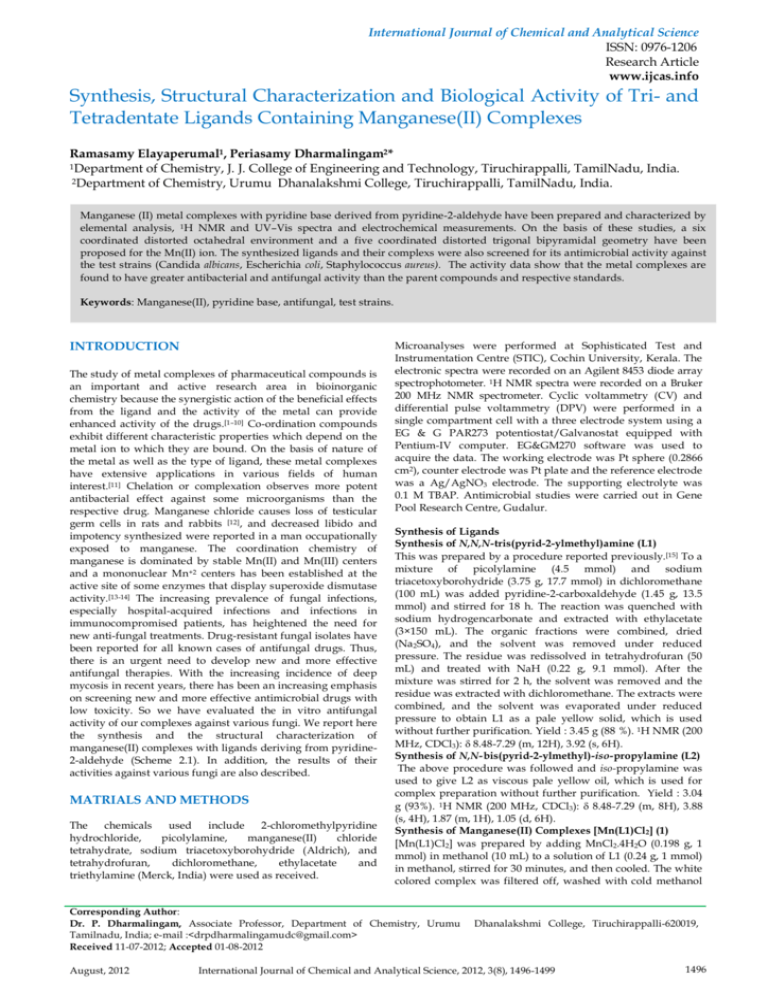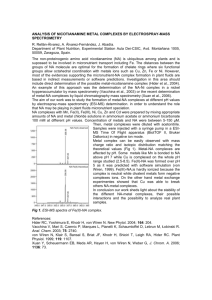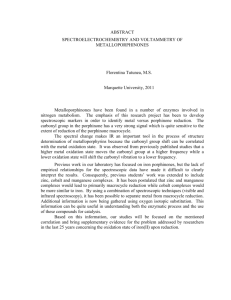Complex - Journal of Pharmacy Research
advertisement

International Journal of Chemical and Analytical Science ISSN: 0976-1206 Research Article www.ijcas.info Synthesis, Structural Characterization and Biological Activity of Tri- and Tetradentate Ligands Containing Manganese(II) Complexes Ramasamy Elayaperumal1, Periasamy Dharmalingam2* 1Department of Chemistry, J. J. College of Engineering and Technology, Tiruchirappalli, TamilNadu, India. 2Department of Chemistry, Urumu Dhanalakshmi College, Tiruchirappalli, TamilNadu, India. Manganese (II) metal complexes with pyridine base derived from pyridine-2-aldehyde have been prepared and characterized by elemental analysis, 1H NMR and UV–Vis spectra and electrochemical measurements. On the basis of these studies, a six coordinated distorted octahedral environment and a five coordinated distorted trigonal bipyramidal geometry have been proposed for the Mn(II) ion. The synthesized ligands and their complexs were also screened for its antimicrobial activity against the test strains (Candida albicans, Escherichia coli, Staphylococcus aureus). The activity data show that the metal complexes are found to have greater antibacterial and antifungal activity than the parent compounds and respective standards. Keywords: Manganese(II), pyridine base, antifungal, test strains. INTRODUCTION The study of metal complexes of pharmaceutical compounds is an important and active research area in bioinorganic chemistry because the synergistic action of the beneficial effects from the ligand and the activity of the metal can provide enhanced activity of the drugs.[1–10] Co-ordination compounds exhibit different characteristic properties which depend on the metal ion to which they are bound. On the basis of nature of the metal as well as the type of ligand, these metal complexes have extensive applications in various fields of human interest.[11] Chelation or complexation observes more potent antibacterial effect against some microorganisms than the respective drug. Manganese chloride causes loss of testicular germ cells in rats and rabbits [12], and decreased libido and impotency synthesized were reported in a man occupationally exposed to manganese. The coordination chemistry of manganese is dominated by stable Mn(II) and Mn(III) centers and a mononuclear Mn+2 centers has been established at the active site of some enzymes that display superoxide dismutase activity.[13-14] The increasing prevalence of fungal infections, especially hospital-acquired infections and infections in immunocompromised patients, has heightened the need for new anti-fungal treatments. Drug-resistant fungal isolates have been reported for all known cases of antifungal drugs. Thus, there is an urgent need to develop new and more effective antifungal therapies. With the increasing incidence of deep mycosis in recent years, there has been an increasing emphasis on screening new and more effective antimicrobial drugs with low toxicity. So we have evaluated the in vitro antifungal activity of our complexes against various fungi. We report here the synthesis and the structural characterization of manganese(II) complexes with ligands deriving from pyridine2-aldehyde (Scheme 2.1). In addition, the results of their activities against various fungi are also described. MATRIALS AND METHODS The chemicals used include 2-chloromethylpyridine hydrochloride, picolylamine, manganese(II) chloride tetrahydrate, sodium triacetoxyborohydride (Aldrich), and tetrahydrofuran, dichloromethane, ethylacetate and triethylamine (Merck, India) were used as received. Microanalyses were performed at Sophisticated Test and Instrumentation Centre (STIC), Cochin University, Kerala. The electronic spectra were recorded on an Agilent 8453 diode array spectrophotometer. 1H NMR spectra were recorded on a Bruker 200 MHz NMR spectrometer. Cyclic voltammetry (CV) and differential pulse voltammetry (DPV) were performed in a single compartment cell with a three electrode system using a EG & G PAR273 potentiostat/Galvanostat equipped with Pentium-IV computer. EG&GM270 software was used to acquire the data. The working electrode was Pt sphere (0.2866 cm2), counter electrode was Pt plate and the reference electrode was a Ag/AgNO3 electrode. The supporting electrolyte was 0.1 M TBAP. Antimicrobial studies were carried out in Gene Pool Research Centre, Gudalur. Synthesis of Ligands Synthesis of N,N,N-tris(pyrid-2-ylmethyl)amine (L1) This was prepared by a procedure reported previously.[15] To a mixture of picolylamine (4.5 mmol) and sodium triacetoxyborohydride (3.75 g, 17.7 mmol) in dichloromethane (100 mL) was added pyridine-2-carboxaldehyde (1.45 g, 13.5 mmol) and stirred for 18 h. The reaction was quenched with sodium hydrogencarbonate and extracted with ethylacetate (3×150 mL). The organic fractions were combined, dried (Na2SO4), and the solvent was removed under reduced pressure. The residue was redissolved in tetrahydrofuran (50 mL) and treated with NaH (0.22 g, 9.1 mmol). After the mixture was stirred for 2 h, the solvent was removed and the residue was extracted with dichloromethane. The extracts were combined, and the solvent was evaporated under reduced pressure to obtain L1 as a pale yellow solid, which is used without further purification. Yield : 3.45 g (88 %). 1H NMR (200 MHz, CDCl3): 8.48-7.29 (m, 12H), 3.92 (s, 6H). Synthesis of N,N-bis(pyrid-2-ylmethyl)-iso-propylamine (L2) The above procedure was followed and iso-propylamine was used to give L2 as viscous pale yellow oil, which is used for complex preparation without further purification. Yield : 3.04 g (93%). 1H NMR (200 MHz, CDCl3): 8.48-7.29 (m, 8H), 3.88 (s, 4H), 1.87 (m, 1H), 1.05 (d, 6H). Synthesis of Manganese(II) Complexes [Mn(L1)Cl2] (1) [Mn(L1)Cl2] was prepared by adding MnCl2.4H2O (0.198 g, 1 mmol) in methanol (10 mL) to a solution of L1 (0.24 g, 1 mmol) in methanol, stirred for 30 minutes, and then cooled. The white colored complex was filtered off, washed with cold methanol Corresponding Author: Dr. P. Dharmalingam, Associate Professor, Department of Chemistry, Urumu Tamilnadu, India; e-mail :<drpdharmalingamudc@gmail.com> Received 11-07-2012; Accepted 01-08-2012 August, 2012 Dhanalakshmi College, Tiruchirappalli-620019, International Journal of Chemical and Analytical Science, 2012, 3(8), 1496-1499 1496 Elayaperumal and Dharmalingam: Synthesis, Stuctural Characterization and Biological Activity of Tri- and Tetradentate Ligands Containing Manganese(II) Complexes and diethylether, and then dried under vacuum. Yield: 0.19 g (80 %). [Mn(L2)Cl2] (2) This was synthesized by using same procedure as described for the [Mn(L1)Cl2] by reacting MnCl2.4H2O (0.20 g, 1 mmol) with L2 (0.24 g, 1 mmol). Yield: 0.23 g (63 %). In vitro anti-microbial screening Disc diffusion method All methodology and steps were followed according to CLSI except for disc content. Concentration of disc content was roughly estimated by comparing the zone of inhibition values to that of known antibiotics. An inoculums of 0.5 Mc Farland standard (108 cfu/mL) was applied on Mueller Hinton Agar (a depth of 4 mm in a petridish of 100 mm diameter). Maximum six discs were applied on each plate and they were incubated a t 350C for 16-18 hours. Zone of inhibition was measured including the disc diameter (6 mm). Antimicrobial activity was indicated by the presence of monochromator. H2N O N + Na(CH3COO)3BH N N N N THF O H3C CH3 Na(CH3COO)3BH NH2 + HC 3 CH3 THF N N The tripodal/linear tetra- and tridentate ligands L1 and L2 are expected to impose distorted octahedral geometry and either distorted square pyramidal or trigonal bipyramidal geometry respectively around the manganese(II) center. Since the manganese ion is in +2 oxidation state, the metal complexes of pyridine-based ligands (L1 and L2) offered high-spin d5 system as reported in the literature. Conductivity studies in methanol solution (M, 80-105 -1 cm2 mol-1) suggest that one of the chloride ions is not coordinated to the metal center. 3.2 Electronic spectra The complexes shows three bands in the range 213 - 415 nm, which are assigned as the interelectronic transitions between * (248 nm for complex 1 and 250 nm for complex 2), n* (213 nm for complex 1 and 215 nm for complex 2) and d-d transition (409 nm for complex 1 and 415 nm for complex 2) respectively. 3.3 Electrochemical measurements The electrochemical features of the manganese(II) complexes were investigated in methanol solution by employing cyclic (CV) and differential pulse voltammetry (DPV) on a stationary platinum-sphere electrode. The redox potentials of the present complexes are summarized in Table 2. By comparison to the electrochemical data given in the literature for similar type of manganese(II) complexes, the following assignments can be made for the present system. The present complexes display one electron redox process around E1/2 = 412 to 585 mV with Ep = 85-90 mV, corresponding to Mn(II)/Mn(III) redox couple. Another one around 700-980 mV originating from the Mn(III)/Mn(IV) redox couple. N N The ligands were reacted with equimolar amount of MnCl24H2O in methanol to give mononuclear manganese(II) complexes in good yield. N Scheme 2.1. Synthesis of ligands RESULTS AND DISCUSSION Table 1: Microanalytical data of ligands and Mn(II) complexes Ligands complexes L1 L2 [Mn(L1)Cl2] [Mn(L2)Cl2] Colour Empirical formula C18H18N4 C15H19N3 MnC18H18N4Cl2 MnC15H19N3Cl2 yellow yellow White White Molecular weight 290.153 241.158 415.029 366.034 Elemental analysis C 74.47(74.43) 74.65(74.63) 51.94(51.91) 49.07(49.05) H 6.26(6.23) 7.94(7.92) 4.36(4.34) 5.22(5.19) Calculated (found) (%) N 19.30(19.28) 17.41(17.37) 13.50(13.46) 11.48(11.44) Table 2: Electrochemical dataa of mononuclear manganese(II) complexes in methanol solution at 25 ± 0.2°C E1/2 Complex Epa(mV) Epc(mV) Redox process Ep(mV) CV(mV) [Mn(L1)Cl2] 456.5 368.5 88 412.5 [Mn(L2)Cl2] 625.5 538.5 87 582.0 Anti-microbial studies of Mn(II) complexes Anti-microbial activity of the present complexes were explored by determining zone of inhibition (Disc Diffusion Tests) using nystatin/chloramphenicol as reference standard (Table 3) at 0.25 %, 0.50 % and 1 % concentration. In order to establish the role of the transition metal center already bound August, 2012 DPV(mV) 411.5 707.5 585.5 977.5 MnII MnIII MnII MnIII MnIII MnIV MnIII MnIV to the ligand on the growth of bacteria, we have initiated a study on the antimicrobial activity of 1 and 2 against microbes and the data were compared with the results obtained for the free non-coordinated ligands L1 and L2. The observed order of zone of inhibition was Candida albicans > Staphylococcus aureus > Escherichia coli . The data reveal that the International Journal of Chemical and Analytical Science, 2012,3(8),1496-1499 1497 Elayaperumal and Dharmalingam: Synthesis, Stuctural Characterization and Biological Activity of Tri- and Tetradentate Ligands Containing Manganese(II) Complexes antimicrobial activity of the complexes is superior to that of the starting materials and standard reference against same microbes under identical experimental conditions. Out of the two complexes 1 and 2, the antimicrobial activity of 1 is found to be more effective than that of 2 because of the presence of tetradentate ligand which results in greater chelation. The increased activity of metal chelates can be explained on the basis of the overtone concept and chelation theory. According to the overtone concept of cell permeability, the lipid membrane that surrounds the cell favors the passage of only lipid-soluble materials in which liposolubility is an important factor that controls the antimicrobial activity. On chelation the polarity of the metal ion will be reduced to a greater extent due to overlap of ligand orbital and partial sharing of the positive charge of the metal ion with donor groups. Further it increases the delocalization of π-electrons over the whole chelate ring and enhances the lipophilicity of complexes. It is likely that the increased liposolubility of the ligand upon metal complexation may contribute to its facile transport into the bacterial cell which blocks the metal binding sites in enzymes of microorganisms. Table 3: Antimicrobial activity (Zone of Inhibition) of ligands and Mn(II) complexes Test compound L1 L2 [MnL1(Cl)2] [MnL2(Cl)2] Standard (Chloramphenicol) Antimicrobial activity E. coli C. albicans 0.25% 11 8 27 24 0.5% 9 6 32 27 17 1% 8 6 29 25 0.25% 6 5 16 13 0.5% 6 4 19 16 14 S. aureus 1% 8 3 19 17 0.25% 9 6 18 16 0.5% 8 7 24 21 20 1% 8 7 27 25 Values of zone of inhibition [mm, including the diameter of the disk (6 mm)] These complexes also disturb the respiration process of the cell and thus block the synthesis of proteins, which restricts further growth of the organism. This would suggest that the chelation could facilitate the ability of a complex to cross a cell membrane[16] and can be explained by Tweedy’s chelation theory.[17] Chelation considerably reduces the polarity of the metal ion because of partial sharing of its positive charge with donor groups and possible π-electron delocalization over the whole chelate ring. Such a chelation could enhance the lipophilic character of the central metal atom, which subsequently favours its permeation through the lipid layer of the cell membrane. The variation in the effectiveness of different compounds against different organisms depends either on the impermeability of the cells of the microbes or on differences in ribosome of microbial cells. The enhanced activity of the complexes can also be explained on the basis of their high solubility (as a result, water-soluble complexes are readily accumulated in bacterial and fungal cells, resulting in the activation of enzymes), fineness of the particles, size of the metal ion and the presence of bulkier organic moieties. CONCLUSIONS The authors thank the Head, Department of Chemistry, UDC, Trichy for providing Laboratory facilities. REFERENCES 1. 2. 3. 4. 5. 6. 7. Many drugs possess modified toxicological and pharmacological properties when in the form of metal complexes[18]. In the present work mononuclear manganese(II) complexes of N,N,N-tris(pyrid-2ylmethyl)amine (L1) and N,N-bis(pyrid-2-ylmethyl)-isopropylamine (L2) have been isolated and characterized. The electrochemical properties of the Mn(II) complexes have also been studied in methanol solution using cyclic and differential pulse voltammetric techniques with a view to relate the electrochemical behavior to the structural aspects and biological reactivity of the complexes. The electronic spectral properties of the complexes have also been studied. These complexes were also subjected to find out their antimicrobial activity and the complex 1 exhibits greater activity than the complex 2 and also both the complexes show greater activity than the respective standards. August, 2012 ACKNOWLEDGEMENTS 8. 9. 10. 11. Bloemink MJ, Reedijk J, Sigel H, Sigel A, Metal Ions in Biological Systems, Marcel Dekker, New York, 32, 1996, 641. Reedijk J, Improved understanding in platinium antitumour chemistry, Chem. Commun., 1996, 801. Roat RM, Jerardi MJ, Kopay CB, Heath DC, Clark JA, DeMars JA, Weaver JM, Bezemer E, Reedijk J, Platinum(II) complexes catalyze reactions between platinum(IV) complexes and 9-methylxanthine, J. Chem. Soc., Dalton Trans., 1997, 3615. Farrell N, Transition Metal Complexes as Drugs and Chemotherapeutic Agents, Kluwer, Dordrecht, 1989. Keppler BK, Metal Complexes in Cancer Chemotherapy, VCH, Weinheim, 1993. Bau R, Huang SKS, Feng JA, McKenna CE, The preparation and crystal structures of new platinum/phosphonate complexes, J. Am. Chem. Soc. 110, 1988, 7546. McCaffrey LJ, Henderson W, Nicholson BK, Mackay JE, Dinger MB, Platinum(II), palladium(II), and nickel(II) thiosalicylate complexes, J. Chem. Soc., Dalton Trans., 1997, 2577. Blaha L, Lukes I, Rohovec J, Hermann P, Complexes of platinum(II) and palladium(II) with aminomethylphosphonic acid and glycylaminomethylphosphonic acid, J. Chem. Soc., Dalton Trans., 1997, 2621. Cavaglioni A, Cini R, The first crystal structure of a rhodium complex with the antileukaemicdrug purine-6-thione; synthesis and molecular orbital investigation ofnew organorhodium(III) compounds, J. Chem. Soc., Dalton Trans., 1997, 1149 Ceci E, Cini R, Konopa J, Maresca L, Natile G, Coordination and peri-Carbon Metalation of 1-Nitro-9-[(2aminoethyl)amino]acridines toward Platinum(II). Evidences for Hydrogen Bonding between Endocyclic N(10)H and Chloride Ion, Inorg. Chem., 35, 1996, 876. Johari R, Kumar G, Kumar D, Singh S, Antibacterial Activity of Copper and Cobalt Amino Acids Complexes, J. Ind. Coun. Chem., 26, 2009, 23. International Journal of Chemical and Analytical Science, 2012,3(8),1496-1499 1498 Elayaperumal and Dharmalingam: Synthesis, Stuctural Characterization and Biological Activity of Tri- and Tetradentate Ligands Containing Manganese(II) Complexes 12. 13. 14. 15. Dixon RH, Reproductive Toxicology, Raven Press, NewYork, 1985, 309. Ludwig ML, Pattridge KA, Stalling WC, Schramm VL, Wedler FC, In Manganese in Metabolism and Enzyme Function, Academic Press, New York, 1986, 405. Beyer WF, Fridovich I, Schramm VL, Welder FC, In Manganese in Metabolism and Enzyme Function, Academic Press, New York, 1986, 193. Britovsek GJP, England J, White AJP, Non-heme Iron(II) Complexes Containing Tripodal Tetradentate Nitrogen 16. 17. 18. Ligands and Their Application in Alkane Oxidation Catalysis, Inorg. Chem., 44, 2005, 8125. Allardyce CS, Dyson PJ, Ellis DJ, Salter PA, Synthesis and characterisation of some water soluble ruthenium(II)–arene complexes and an investigation of their antibiotic and antiviral properties, J. Organomet. Chem., 2003, 35, 668. Tweedy BG, Phytopathology, 1964, 55, 910. Sultana N, Arayne MS, In vitro activity of cefadroxil, cephalexin, cefatrizine and cefpirome in presence of essential and trace elements, Pak. J. Pharm. Sci., 2007, 20, 305. Source of support: Nil, Conflict of interest: None Declared August, 2012 International Journal of Chemical and Analytical Science, 2012,3(8),1496-1499 1499





